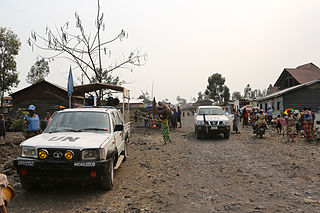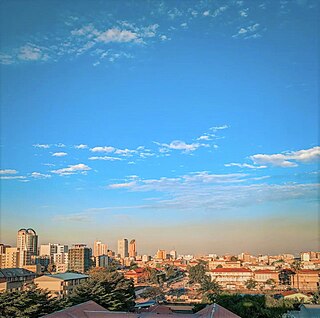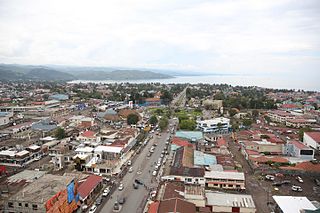
Kinshasa, formerly named Léopoldville until 30 June 1966, is the capital and largest city of the Democratic Republic of the Congo. Kinshasa is one of the world's fastest-growing megacities, with an estimated population, in 2024, of 17,032,322. It is the most densely populated city in the DRC, the most populous city in Africa, the world's fourth-most-populous capital city, Africa's third-largest metropolitan area, and the leading economic, political, and cultural center of the DRC. Kinshasa houses several industries, including manufacturing, telecommunications, banking, and entertainment. The city also hosts some of DRC's significant institutional buildings, such as the People's Palace, Palace of the Nation, Court of Cassation, Constitutional Court, African Union City, Marble Palace, Martyrs Stadium, Government House, Kinshasa Financial Center, and other national departments and agencies.

Karisimbi is a commune in Goma in the North Kivu Province of the eastern region of the Democratic Republic of the Congo. The commune takes its name from the nearby Mount Karisimbi, a prominent volcano in the Virunga Mountains. Spanning an area of approximately 33,372 square kilometers, Karisimbi extends from Goma International Airport to the outskirts of the Mugunga neighborhood. It is bordered by the Masisi Territory to the south and Rwanda to the east.

Bandalungwa is a commune in the Funa District of Kinshasa in the western region of the Democratic Republic of the Congo. Covering an area of 6.82 square kilometers, Bandalungwa is centrally situated within the city. It is bordered by the Gombe commune and the Kokolo military barracks to the north, Selembao to the south, the communes of Ngiri-Ngiri, Kasa-Vubu, and Lingwala to the east, and the Makelele River, Ngaliema, and Kintambo to the west. The commune had an estimated population of 934,821 in 2015, although official census data from 2016 reported a significantly lower figure of 259,760 residents.

Bumbu is a commune situated in the Funa District of Kinshasa. Spanning an area of 5.30 square kilometers, it is located in the hilled southern section of the city and had an estimated population of 905,943 as of 2015. Bumbu is bordered by Kwilu Street to the north, which separates it from Ngiri-Ngiri; Kimvula "Haute tension" Street to the south; Elengesa Avenue to the east, demarcating it from Makala; and Liberation Avenue to the west, bordering Selembao.

Gombe, also known as La Gombe, or Downtown Kinshasa, is one of the 24 communes of Kinshasa, in the western part of the Democratic Republic of the Congo. Encompassing a vast area of approximately 29.33 square kilometers, it is home to an approximate population of 49,024 residents (2014).

Kalamu is a commune in the Funa District of Kinshasa, located in the western region of the Democratic Republic of the Congo. Covering an area of 6.64 square kilometers, Kalamu lies in the central part of the city-province of Kinshasa. It is bordered by the Kinshasa commune to the north, Makala to the south, and Limete to the east, with Avenue de l'Université marking the boundary. As of 2015, Kalamu had an estimated population of 974,669, while a 2020 estimate noted a decrease to 208,155.

The Boulevard du 30 Juin is a major 5‑km street in Kinshasa, Democratic Republic of the Congo (DRC). It is the city center's main transport artery, connecting the southern area of La Gombe with Kintambo and the Ngaliema to the west.

Selembao is one of the 24 communes that are the administrative divisions of Kinshasa, the capital city of the Democratic Republic of the Congo. Covering over 12 square kilometers and with an estimated population of 1,038,819 as of 2015, it is bordered to the north by the communes of Bandalungwa and Bumbu, to the northeast by Bumbu, to the south by Mont Ngafula, to the east by Makala, and to the west by Ngaliema.

Ngaba is a commune located in the Mont Amba District of Kinshasa, the capital city of the Democratic Republic of the Congo. It spans an area of 4.0 square kilometers and has an estimated population of 539,135 as of 2015.
N'Dolo Airport, also known as Ndolo Airport, is a secondary airport in the city of Kinshasa, Democratic Republic of the Congo, located in the commune of Barumbu near the city center.

Makala is a commune located in the Funa District of Kinshasa, the capital city of the Democratic Republic of the Congo. Covering an area of 5.60 square kilometers, Makala is situated in Kinshasa's southern hilly region and has an estimated population of 698,495 as of 2015.

Lemba is a commune in the Mont Amba District of Kinshasa, the capital of the Democratic Republic of the Congo. Spanning an area of 23.70 square kilometers, it has an estimated population of 1,120,992 as of 2015. Lemba is bordered by several communes, with the Limete commune to the north, the Kalamu River forming a natural boundary with Ngaba to the northwest, and Makala to the southwest. The Kimwenza road marks its border with Mont-Ngafula, while the Matete River separates it from Matete to the northeast and Kisenso to the southeast.

Limete is one of the 24 communes that are the administrative divisions of Kinshasa, the capital city of the Democratic Republic of the Congo.

Matete is one of the 24 communes of Kinshasa, the capital city of the Democratic Republic of the Congo. Situated in the Mont Amba District in the southern part of Kinshasa, Matete spans an area of 4.80 square kilometers and had an estimated population of 854,908 as of 2015. It shares borders with the communes of Lemba and Limete to the north, Kisenso to the south, N'djili to the east, and Lemba to the west.

Goma is a commune located in the city of Goma, within North Kivu Province in the eastern Democratic Republic of the Congo. Covering an area of 33,245 square kilometers, it forms the southernmost part of the city while also including sections of its eastern and western regions. As of 2018, the commune's population was estimated at approximately 333,727 residents. Goma is bordered by Lake Kivu to the south, the Republic of Rwanda to the east, Karisimbi commune to the north, and Masisi Territory to the west.

The Kinshasa Central Market, colloquially referred to as Zando ya Monene or simply Zando (Market) in Lingala, is a marketplace located in Kinshasa's Gombe commune, in the Democratic Republic of the Congo. Covering an expansive 90,000 square meters, it was Kinshasa's largest marketplace during Mobutu Sese Seko's reign. It was eventually eclipsed by the Marché de la Liberté during the late president Laurent-Désiré Kabila's administration. As of May 1989, the market accommodated 15,500 vendors. By 2020, that number had risen to 35,000 vendors. Renowned for its wide assortment of products, including fruits, vegetables, meat, fish, spices, cooked meals such as chikwangue, clothing, fabrics, shoes, accessories, and household goods, the marketplace also showcases distinctive Congolese handicrafts and souvenirs for tourists and visitors.

The Gare de l'Est, also known as Kinshasa Est or Kinshasa Central Station, is a central railway station situated in the Gombe commune of Kinshasa, Democratic Republic of the Congo (DRC). Positioned along the Matadi–Kinshasa Railway line, it functions as a pivotal transshipment point connecting the railway and the river. Managed by the Société Commerciale des Transports et des Ports (SCTP), the station stands near Ngobila Beach at the Port of Kinshasa, fostering maritime links with Brazzaville, and is conveniently located close to SCTP buildings and the Ministry of Transport and Channels of Communication.
The Université Pédagogique Nationale, formerly named the Institut Pédagogique National, colloquially referred to by its acronym UPN, is a public institution of higher education dedicated to training teachers, enhancing their skills, and promoting studies and research in applied pedagogy. Strategically located in Ngaliema commune, it is bordered by the Binza-Pigeon neighborhood to the north, Avenue de la Libération to the south, the road to Matadi to the west, and the Camping neighborhood of Selembao commune to the east.

The Matete Market, also known as Matete Municipal Market, is a marketplace located in Matete, Kinshasa. Situated in the southern part of the city on a marshy alluvial plain, it is the third-largest market in Kinshasa and a vital economic center for the surrounding area. The market features a diverse range of sales facilities, categorized into four types based on their level of equipment and the income levels of the businesses operating within them. These include enclosed shops and store, semi-open pavilions supported by structural posts, vendor tables, and rudimentary open-air setups at ground level.
University Avenue is a north–south road in Kinshasa, Democratic Republic of the Congo. Serving as one of the city's main traffic arteries, it spans the urban area from its northern terminus at the intersection of Sendwe Avenue and Lumumba Boulevard—marking the boundary between the communes of Kalamu and Limete—to its southern end at the University of Kinshasa campus in the commune of Lemba. Along its route, the avenue intersects major roads such as Victoire Avenue, Bongolo Avenue, Yolo Avenue, and Kapela Avenue, while passing key landmarks including the Ezo Roundabout and the Ngaba Roundabout, where it separates the communes of Makala and Ngaba.

















